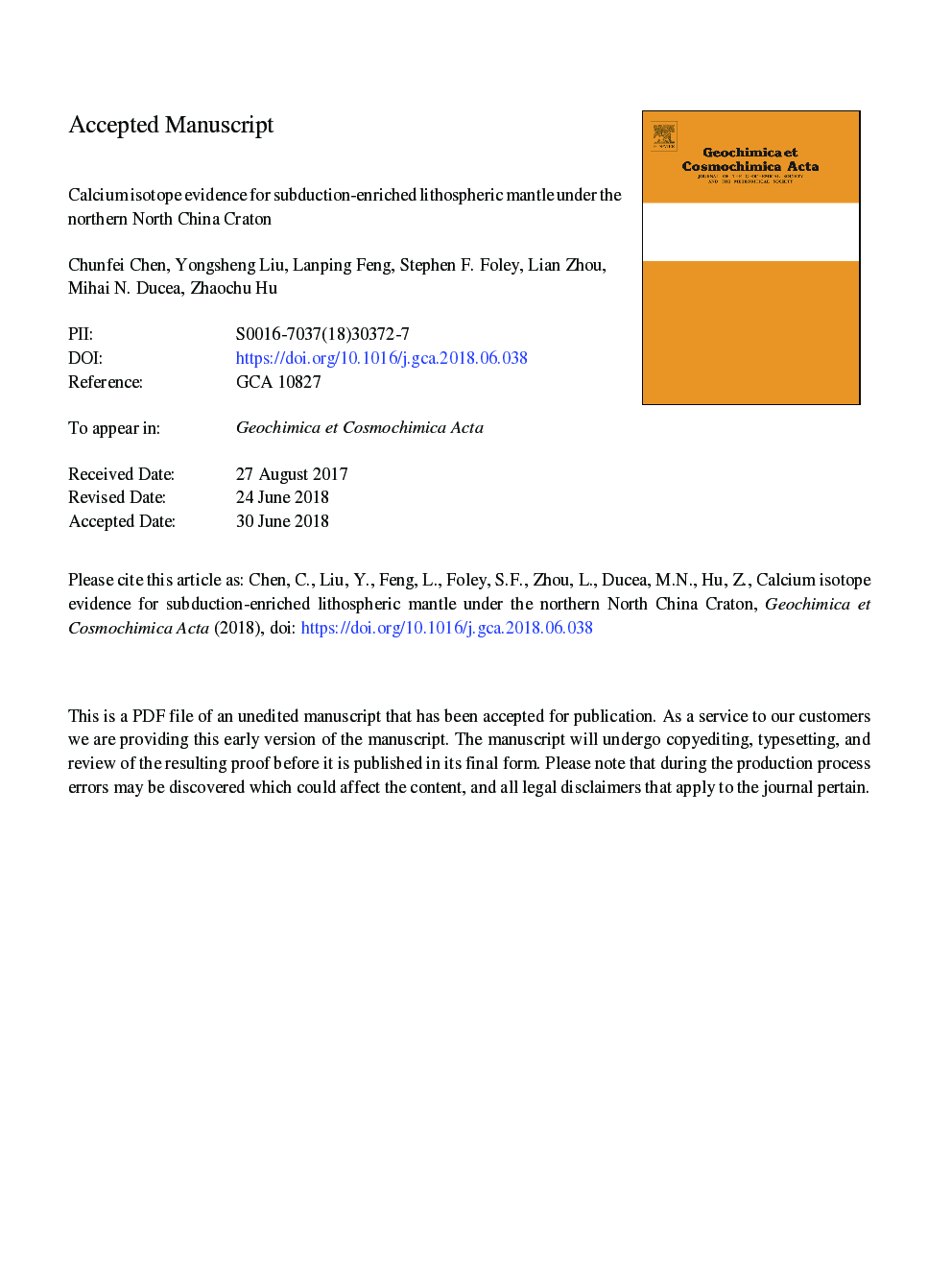| کد مقاله | کد نشریه | سال انتشار | مقاله انگلیسی | نسخه تمام متن |
|---|---|---|---|---|
| 8910590 | 1637919 | 2018 | 38 صفحه PDF | دانلود رایگان |
عنوان انگلیسی مقاله ISI
Calcium isotope evidence for subduction-enriched lithospheric mantle under the northern North China Craton
ترجمه فارسی عنوان
شواهد ایزوتوپ کلسیم برای مانت لیتوسفریک غنی شده با فروکتوز زیر کرتون شمالی شمالی چین
دانلود مقاله + سفارش ترجمه
دانلود مقاله ISI انگلیسی
رایگان برای ایرانیان
کلمات کلیدی
ایزوتوپهای کلسیم، پریدوتیت، متاسوماتیسم، فرومغناطیس، رسوبات کربناته،
موضوعات مرتبط
مهندسی و علوم پایه
علوم زمین و سیارات
ژئوشیمی و پترولوژی
چکیده انگلیسی
The stable isotopes of calcium have tremendous potential for constraining the evolution of the mantle as well as fingerprinting the recycling of carbon in the mantle via subduction. In order to better identify possible contributions of subducted carbonate-bearing materials to upper mantle heterogeneity, we present Ca isotope data for peridotite xenoliths from Fanshi, northern North China Craton. These peridotites have previously been studied for major and trace element, Sr-Nd isotopic compositions. Two metasomatic events in the lithosphere mantle caused by subduction of carbonated sediments from the Pale-Asian oceanic slab, were previously identified: the first by carbonatite melt and the second by carbonate-rich silicate melt. δ44/40Ca (=((44Ca/40Ca)SAMPLE/(44Ca/40Ca)SRM915aâ¯ââ¯1)â¯Ãâ¯1000) of clinopyroxenes (Cpx) in the Fanshi peridotites varies from +0.84â° to +1.17â° and δ44/40Ca of orthopyroxenes (Opx) from +0.82â° to +1.22â°. δ44/40Ca of the clinopyroxenes show a larger variation than that could be attributed to partial melting and display positive and negative trends with (La/Yb)N and Ti/Eu, respectively, suggesting the effect of two distinct metasomatic events. A harzburgite, modified only by the early carbonatite metasomatism, has the highest δ44/40Ca (+1.17â°). The lherzolites affected by the second metasomatic melt show lower Î44/40CaOpx-Cpx (=δ44/40CaOpxâ¯ââ¯Î´44/40CaCpx, â0.11â° to 0â°) than the un-metasomatized lherzolites (+0.11â° to +0.24â°), implying that the second metasomatism triggered Ca isotope disequilibrium between the clinopyroxene and co-existing orthopyroxene. This is consistent with positive trends between δ44/40Ca and 87Sr/86Sr, (La/Yb)N in the clinopyroxenes of the lherzolites, indicating that the second metasomatism also resulted in high δ44/40Ca in the clinopyroxenes of the lherzolites (up to +1.09â°). Furthermore, the harzburgites and lherzolites converge toward the second metasomatic event in diagrams of 87Sr/86Sr versus δ44/40Ca, suggesting an extensive effect of the second metasomatism. The heavy Ca isotope signature in these metasomatic clinopyroxenes applies to both first carbonatite melt and second carbonate-rich silicate melt derived from carbonated sediments (>+1.17â° and â¼+1.09â°, respectively). However, heavy Ca isotope composition is inconsistent with low δ44/40Ca in carbonated sediments from the Paleo-Asian ocean, but could be the characteristic of an evolved sediment-derived hydrous carbonate melt. This implies significant Ca isotope fractionation during subduction of carbonated sediments. While currently there is plenty of debate regarding the exact significance of Ca isotope heterogeneity in mantle rocks, our results show at a minimum that Ca isotopes are rather heterogeneous in supra-subduction mantle rocks and could be used to deciphering mantle metasomatic models and detecting recycled crustal materials.
ناشر
Database: Elsevier - ScienceDirect (ساینس دایرکت)
Journal: Geochimica et Cosmochimica Acta - Volume 238, 1 October 2018, Pages 55-67
Journal: Geochimica et Cosmochimica Acta - Volume 238, 1 October 2018, Pages 55-67
نویسندگان
Chunfei Chen, Yongsheng Liu, Lanping Feng, Stephen F. Foley, Lian Zhou, Mihai N. Ducea, Zhaochu Hu,
